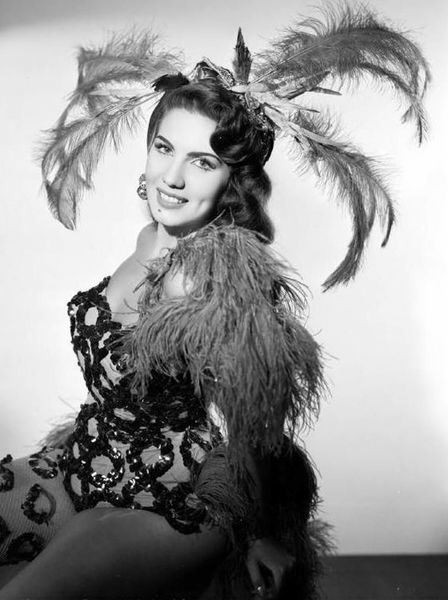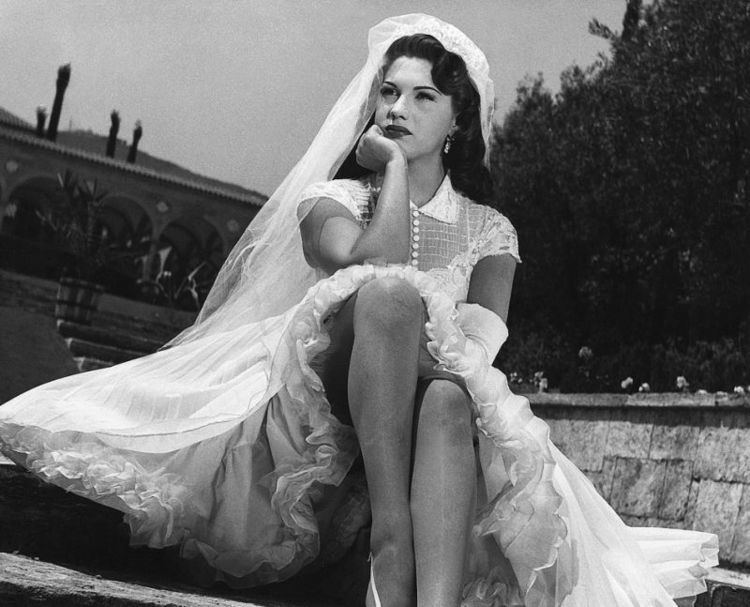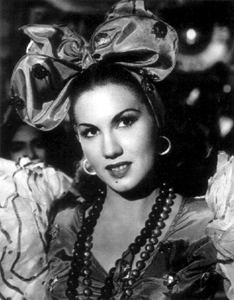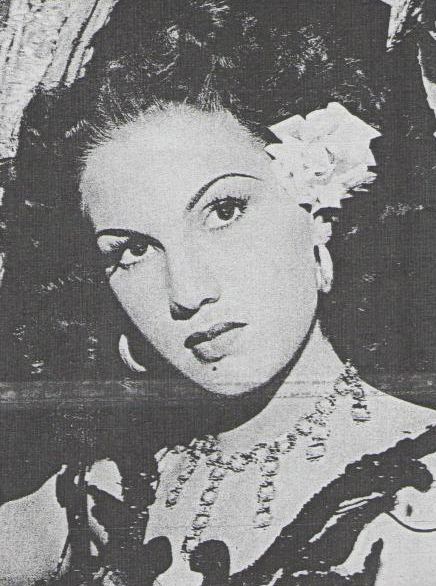Nationality MexicanCuban Name Rosa Carmina | Years active 1946–1992 Role Film actress | |
 | ||
Full Name Rosa Carmina Riveron Jimenez Occupation Actress, dancer and singer Parents Juan Bruno Riveron, Encarnacion Jimenez Movies Viajera, Sandra - la mujer de fuego, Bellas de noche, Pantaleon y las visitadoras, Rastro de muerte Similar People Juan Orol, Maria Antonieta Pons, Maria Esquivel, Alberto Gout, Miguel M Delgado | ||
¿QUE FUE DE ROSA CARMINA?
Rosa Carmina Riveron Jimenez (born November 19, 1929 in Havana, Cuba) is a Mexican film actress, dancer and singer of Cuban origin, regarded as one of the leading figures of the Rumberas film of the Golden Age of Mexican cinema. She is also known as the Queen of the Gangsters, for her participation in numerous films of the gangster genre directed by the filmmaker Juan Orol.
Contents
- QUE FUE DE ROSA CARMINA
- Early life
- Film
- Stage performances
- Television
- Personal life
- Anecdotes
- TV
- Filmography
- References

Early life

Rosa Carmina Riveron Jimenez was born in Havana, Cuba on November 19, 1929 to Juan Bruno Riveron and Encarnacion Jimenez. From an early age, she showed interest in dancing, and studied at the School of Dance in Cuba. In 1946 the famous Spanish producer, director and film actor Juan Orol, divorced the Cuban rumbera Maria Antonieta Pons, ending their collaboration in the Mexican Cinema. Orol then traveled to Cuba to search for a new star for his films. He launched a competition in Havana where about five hundred girls attended (among the contestants were the rumberas Ninon Sevilla and Mary Esquivel). He was unable to find an actress to play the character of a Japanese spy in the film Una mujer de Oriente, so he decided to return to Mexico. However, Orol unexpectedly received a call from Enrique Brion, his agent in Cuba. Brion had come by invitation to the graduation celebration bachelor of Juanita Riveron, Rosa's sister, where he heard Rosa Carmina sing. Brion told Orol about his discovery. Upon meeting Rosa the next day, Orol claimed to have felt a great emotion, and thought to himself: This is la mujer de Oriente.

Orol fell for Rosa and offered her a contract to star in three films in Mexico. Rosa initially rejected his offer, because she was betrothed to the military Francisco Morales Llanes. However, Orol convinced her, and Rosa decided to travel with him to Mexico, accompanied by her family. Juan Orol taught Rosa her best dance moves. Later, he sent for choreographers from around the world. Rosa also took acting classes at the studio of Seki Sano.
Film
Rosa Carmina began her artistic career in the Mexican Cinema starring in the film Una mujer de Oriente (1946), directed by Juan Orol. Rosa had signed a contract to film two more films with Orol. Her second project was Tania, la bella salvaje (1947). Her third film made with Orol was El reino de los gangsters (1947). Both this film and its sequel, Gangsters Versus Cowboys (1948), are now considered cult films in the Gangsters film genre, and have an important place in several film libraries around the world. Despite being an exclusive star of Orol, Orol gave her the chance to shoot with other directors. Her first film that was not directed by Orol was La bandida (1948). To close the 1940s, Rosa filmed two more films with Orol: Amor salvaje (1949) and Cabaret Shanghai (1950). The success of Rosa Carmina in the cinema increased her versatility. Soon after, she proved to be a "complete star", because she not only demonstrated her talent for dancing, but also for singing and acting.
In 1951, again under the direction of Orol, Rosa Carmina shot the film trilogy Percal, consisting of three films: Hombres sin alma, El infierno de los pobres and Perdicion de mujeres. This trilogy was based on an original comic book by Jose G. Cruz, and was a huge success at the box office. In 1950, Rosa shot with the production company Producciones Rosas Priego. At this studio, Rosa Carmina had the opportunity to make dramatic films with very different plots: she filmed movies like Traicionera (1950), with Fernando fernandez, En carne viva (1951), with Ruben Rojo, Especialista en senoras (1952), with Rafael Baledon and La segunda mujer (1954), with Antonio Aguilar, among others. Rosa Carmina was also originally considered to star in the film un extrano en la escalera, directed by the filmmaker Tulio Demicheli, next to Arturo de Cordova. However, Rosa rejected the project to join a new film project with Orol: Sandra, la mujer de fuego (1954). She was then replaced by Silvia Pinal. Sandra, la mujer de feugo was one of the most important and memorable films of her career. In total, Orol directed her in sixteen films.
In the mid 1950s, the Rumberas film experienced a decline. Like other exponents of the genre, Rosa Carmina made fewer productions in this genre. Her last great success within the genre was the Spanish-Mexican co-production Quiereme con musica (1956), directed by Ignacio Iquino. The film was a great success in the Spanish market, making Carmina one of the few Mexican stars to achieve success in Spain. From this point on, Rosa Carmina performed musical numbers only sporadically in her films.
In 1956, Rosa Carmina received an offer to make a film in France with actress Viviane Romance, but because the movie would contain lesbian scenes, Juan Orol recommended that she reject the project.
In the late 1950s and during the 1960s, Rosa Carmina ventured into other film genres. Carmina's career stands out because of her versatility in working in different genres while keeping the same success with the public. Few actresses in the Mexican cinema were able to do this. She was part of the era of the Luchador films for her involvement in films like La ultima lucha (1959) and La sombra blanca (1964). She also ventured into the fantasy and horror film genres in films like El misterio de la cobra (1959), Rostro infernal (1963) and La huella macabra (1963). In 1974, Rosa Carmina met for the last time with Juan Orol in the film Mexico de noche, where made his last appearance Sandra and the serie of characters created by Orol to his classic films. In 1975, Rosa appeared in the film Bellas de noche, which introduced the Cine de Ficheras that flourished between the 1970s and 1980s in the Mexican Cinema.
In 1976, the Peruvian Nobel Prize winner Mario Vargas Llosa directed her in Pantaleon y las visitadoras, based on his novel of the same name. Rosa was considered for the role of Chuchupe. Mario Vargas Llosa himself claimed to have inspired her for the character. However, they realized that Rosa was too physically attractive to play an obese and decadent woman. The character was then performed by Katy Jurado, although a special character was created so that they could keep Rosa Carmina in the cast. The film was produced by Paramount Pictures and made in the Dominican Republic.
In 1981, Rosa appeared in the Arturo Ripstein film Rastro de muerte. Her last film was Teatro Follies, a musical film made for television in 1983, in which she shared credit with Maria Victoria and Tongolele.
In 1992, Rosa was considered for a role in the film Los anos de Greta. However, her physical attractiveness was again an impediment to the realization of the character she was intended to play, so she was replaced by the rumbera Meche Barba.
Stage performances
Carmina also performed in arenas, stadiums, cabaret, public theaters and nightclubs around Central and South America, which achieved significant success in an era when the television was not yet considered a mass medium. Her foray into the theater in Mexico occurred shortly after her arrival to the country and after the success of the film Tania, la bella salvaje. Juan Orol organized a tour throughout the country for Rosa Carmina, where he presented her live to the public. Eventually, Rosa entered in a musical revue presented at the Tivoli Theatre in Mexico City, where she shared scenes with figures like Libertad Lamarque, Rosita Fornes and Los Panchos.
In 1976 she starred in a successful music season in the Blanquita Theater of Mexico City, alongside the comedian Adalberto Martinez and the Cuban rumbera Amalia Aguilar.
In the early 1990s, Rosa Carmina starred in a show called Rumba, poetry and song, which wove the songs of her films with Cuban poetry and dance. One thousand performances were held at the Teatro Esperanza Iris of Mexico City, coinciding with the 45th anniversary of Rosa Carmina's career, under the sponsorship of the National Council for Culture and the Arts, the Secretariat of Public Education and Leon Alazraki Riveron.
Television
Rosa Carmina has had a very selective presence on Mexican television. She was one of the first figures to present a musical show on Mexican television. At the end of her film career, Rosa made her debut in the Mexican telenovelas in 1984, in the telenovela La pasion de Isabela (1984). Probably her most memorable works in this medium are the telenovelas Juana Iris (1985) and Muchachita (1986), where she played special characters written especially for her by the writer Ricardo Renteria. In 1992 she participated in the telenovela Maria Mercedes (1992), the first of the successful television soap opera trilogy known as the Trilogy of the Marias, starring the singer Thalia. She played a minor character and got her role due to her friendship with the soap opera's writer Carlos Romero. This is, to date, her last professional work as an actress.
Rosa Carmina was initially considered to be part of the cast of the telenovela Marimar. However, Carmina rejected the project and was replaced by Ana Luisa Peluffo.
Personal life
Rosa Carmina has been married several times. Her first husband, Francisco Morales Llanes, was a military and head of the "intelligence" in Cuba during the World War II. After, she married Juan Orol. Her third husband was Ramon de Florez. In her fourth and fifth marriage, she married businessmen of Spanish and Lebanese origin, respectively.
